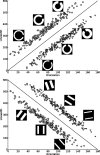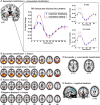Comparing the neural basis of monetary reward and cognitive feedback during information-integration category learning
- PMID: 20053886
- PMCID: PMC6632509
- DOI: 10.1523/JNEUROSCI.2205-09.2010
Comparing the neural basis of monetary reward and cognitive feedback during information-integration category learning
Abstract
The dopaminergic system is known to play a central role in reward-based learning (Schultz, 2006), yet it was also observed to be involved when only cognitive feedback is given (Aron et al., 2004). Within the domain of information-integration category learning, in which information from several stimulus dimensions has to be integrated predecisionally (Ashby and Maddox, 2005), the importance of contingent feedback is well established (Maddox et al., 2003). We examined the common neural correlates of reward anticipation and prediction error in this task. Sixteen subjects performed two parallel information-integration tasks within a single event-related functional magnetic resonance imaging session but received a monetary reward only for one of them. Similar functional areas including basal ganglia structures were activated in both task versions. In contrast, a single structure, the nucleus accumbens, showed higher activation during monetary reward anticipation compared with the anticipation of cognitive feedback in information-integration learning. Additionally, this activation was predicted by measures of intrinsic motivation in the cognitive feedback task and by measures of extrinsic motivation in the rewarded task. Our results indicate that, although all other structures implicated in category learning are not significantly affected by altering the type of reward, the nucleus accumbens responds to the positive incentive properties of an expected reward depending on the specific type of the reward.
Figures




Similar articles
-
The rewarding value of good motor performance in the context of monetary incentives.Neuropsychologia. 2012 Jul;50(8):1739-47. doi: 10.1016/j.neuropsychologia.2012.03.030. Epub 2012 May 6. Neuropsychologia. 2012. PMID: 22569215
-
Age-Related Differences in Motivational Integration and Cognitive Control.Cogn Affect Behav Neurosci. 2019 Jun;19(3):692-714. doi: 10.3758/s13415-019-00713-3. Cogn Affect Behav Neurosci. 2019. PMID: 30980339 Free PMC article.
-
The acute effects of cannabidiol on the neural correlates of reward anticipation and feedback in healthy volunteers.J Psychopharmacol. 2020 Sep;34(9):969-980. doi: 10.1177/0269881120944148. Epub 2020 Aug 5. J Psychopharmacol. 2020. PMID: 32755273 Free PMC article. Clinical Trial.
-
Involvement of basal ganglia and orbitofrontal cortex in goal-directed behavior.Prog Brain Res. 2000;126:193-215. doi: 10.1016/S0079-6123(00)26015-9. Prog Brain Res. 2000. PMID: 11105648 Review.
-
Cognition as coordinated non-cognition.Cogn Process. 2007 Jun;8(2):79-91. doi: 10.1007/s10339-007-0163-1. Epub 2007 Apr 11. Cogn Process. 2007. PMID: 17429705 Review.
Cited by
-
Many hats: intratrial and reward level-dependent BOLD activity in the striatum and premotor cortex.J Neurophysiol. 2013 Oct;110(7):1689-702. doi: 10.1152/jn.00164.2012. Epub 2013 Jun 5. J Neurophysiol. 2013. PMID: 23741040 Free PMC article.
-
A universal role of the ventral striatum in reward-based learning: evidence from human studies.Neurobiol Learn Mem. 2014 Oct;114:90-100. doi: 10.1016/j.nlm.2014.05.002. Epub 2014 May 10. Neurobiol Learn Mem. 2014. PMID: 24825620 Free PMC article. Review.
-
The Effect of Positive and Negative Feedback on Risk-Taking across Different Contexts.PLoS One. 2015 Sep 25;10(9):e0139010. doi: 10.1371/journal.pone.0139010. eCollection 2015. PLoS One. 2015. PMID: 26407298 Free PMC article.
-
Neural mechanisms of goal-directed behavior: outcome-based response selection is associated with increased functional coupling of the angular gyrus.Front Hum Neurosci. 2015 Apr 10;9:180. doi: 10.3389/fnhum.2015.00180. eCollection 2015. Front Hum Neurosci. 2015. PMID: 25914635 Free PMC article.
-
Feature saliency and feedback information interactively impact visual category learning.Front Psychol. 2015 Feb 19;6:74. doi: 10.3389/fpsyg.2015.00074. eCollection 2015. Front Psychol. 2015. PMID: 25745404 Free PMC article.
References
-
- Abler B, Walter H, Erk S, Kammerer H, Spitzer M. Prediction error as a linear function of reward probability is coded in human nucleus accumbens. Neuroimage. 2006;31:790–795. - PubMed
-
- Aron AR, Shohamy D, Clark J, Myers C, Gluck MA, Poldrack RA. Human midbrain sensitivity to cognitive feedback and uncertainty during classification learning. J Neurophysiol. 2004;92:1144–1152. - PubMed
-
- Ashby FG, Alfonso-Reese LA, Turken AU, Waldron EM. A neuropsychological theory of multiple systems in category learning. Psychol Rev. 1998;105:442–481. - PubMed
-
- Ashby FG, Gott RE. Decision rules in the perception and categorization of multidimensional stimuli. J Exp Psychol Learn Mem Cogn. 1988;14:33–53. - PubMed
-
- Ashby FG, Maddox WT. Human category learning. Annu Rev Psychol. 2005;56:149–178. - PubMed
Publication types
MeSH terms
LinkOut - more resources
Full Text Sources
